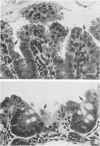Abstract
Adult mice are more resistant than neonatal mice to intestinal colonization with the protozoan parasite Cryptosporidium parvum. Development of a mature intestinal flora may play a role in this resistance. We compared susceptibilities to colonization with C. parvum in adult conventional mice, adult germfree mice, and adult conventional mice treated with oral antibiotics to deplete the intestinal flora. Germfree mice of both CD1 and BALB/c strains were colonized at day 7 following inoculation with C. parvum oocysts isolated from the feces of an infected, diarrheic calf. Age-matched conventional mice of the same strains were comparatively resistant to colonization. Conventional mice treated with antibiotics remained resistant to colonization. These results suggest that the microflora in the intestine was not the sole determinant of resistance or susceptibility to colonization. The germfree adult mouse as an experimental model of cryptosporidiosis is discussed.
Full text
PDF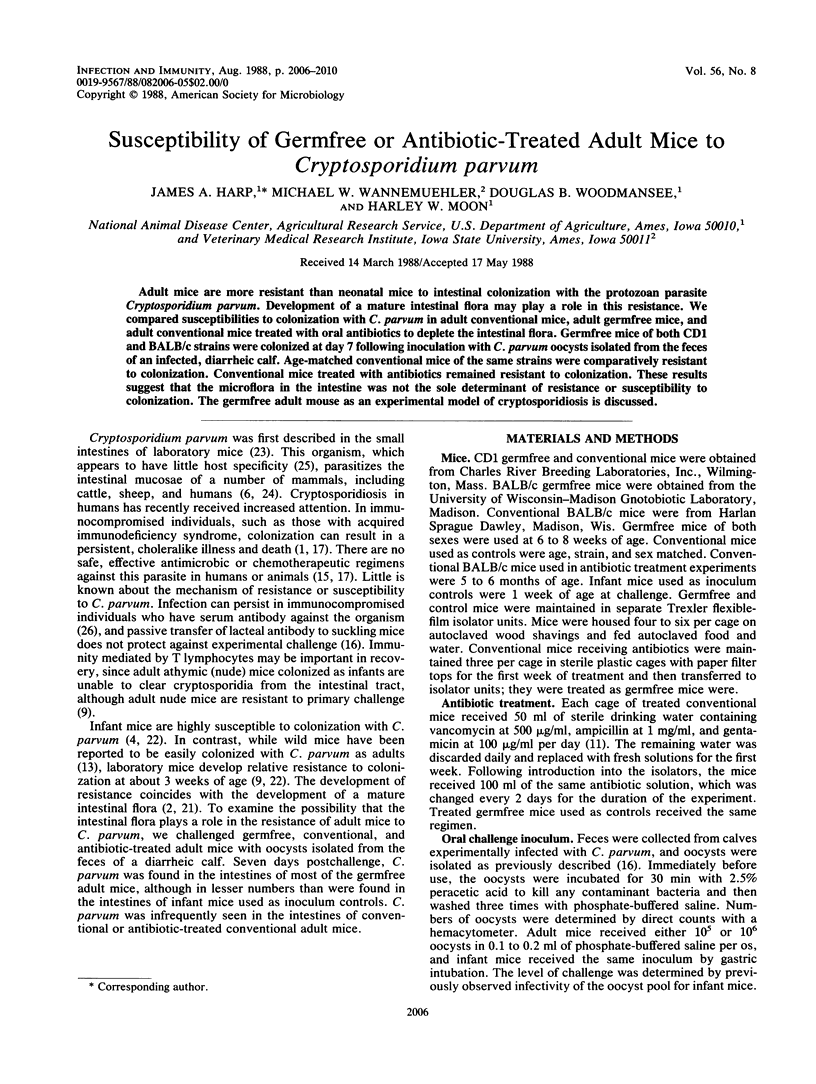
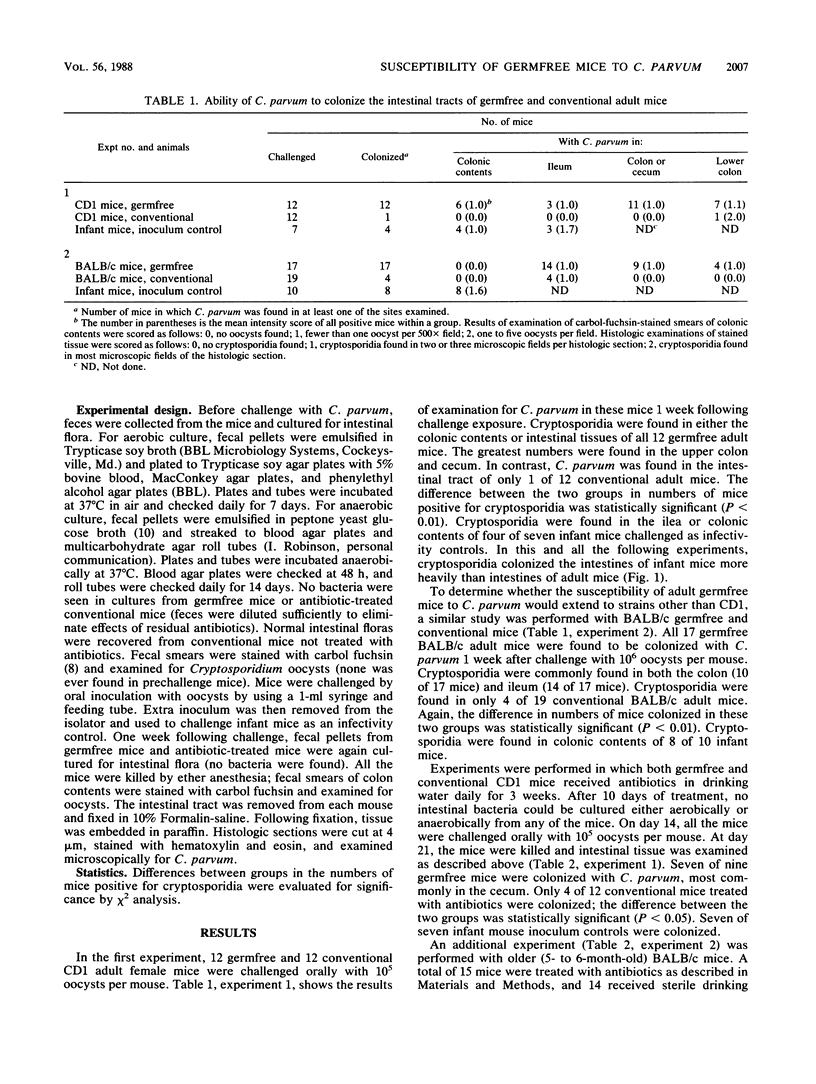
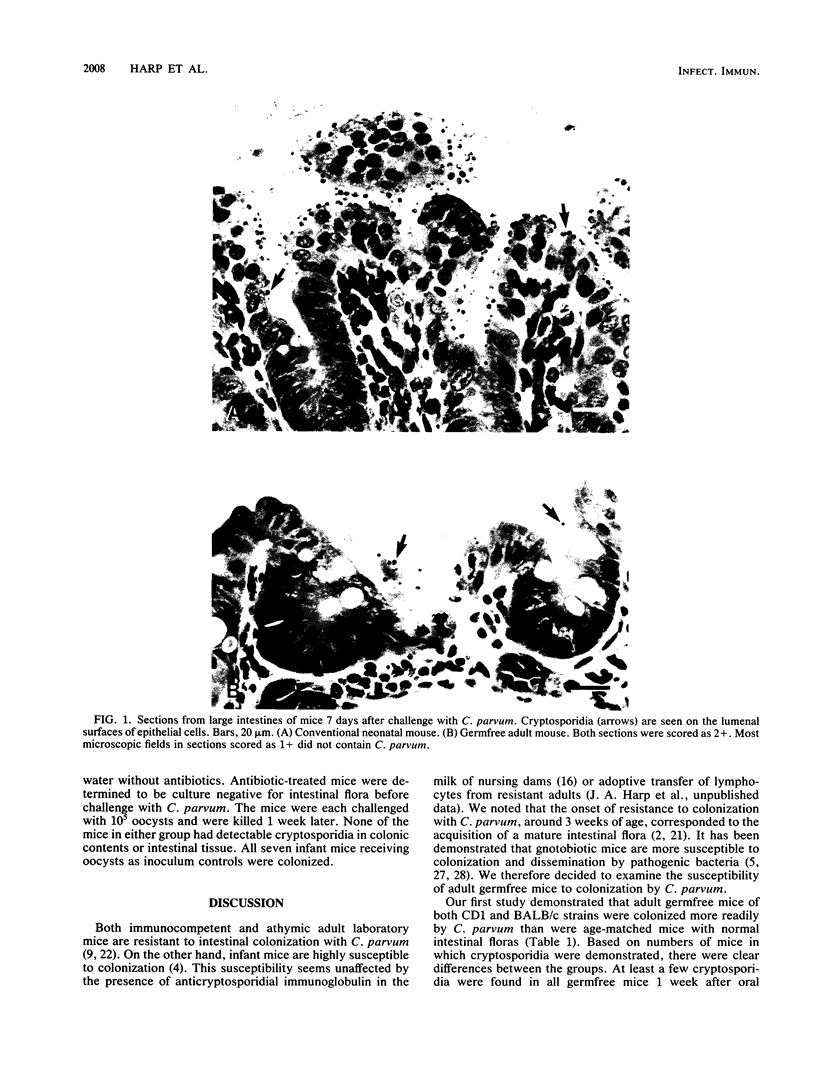
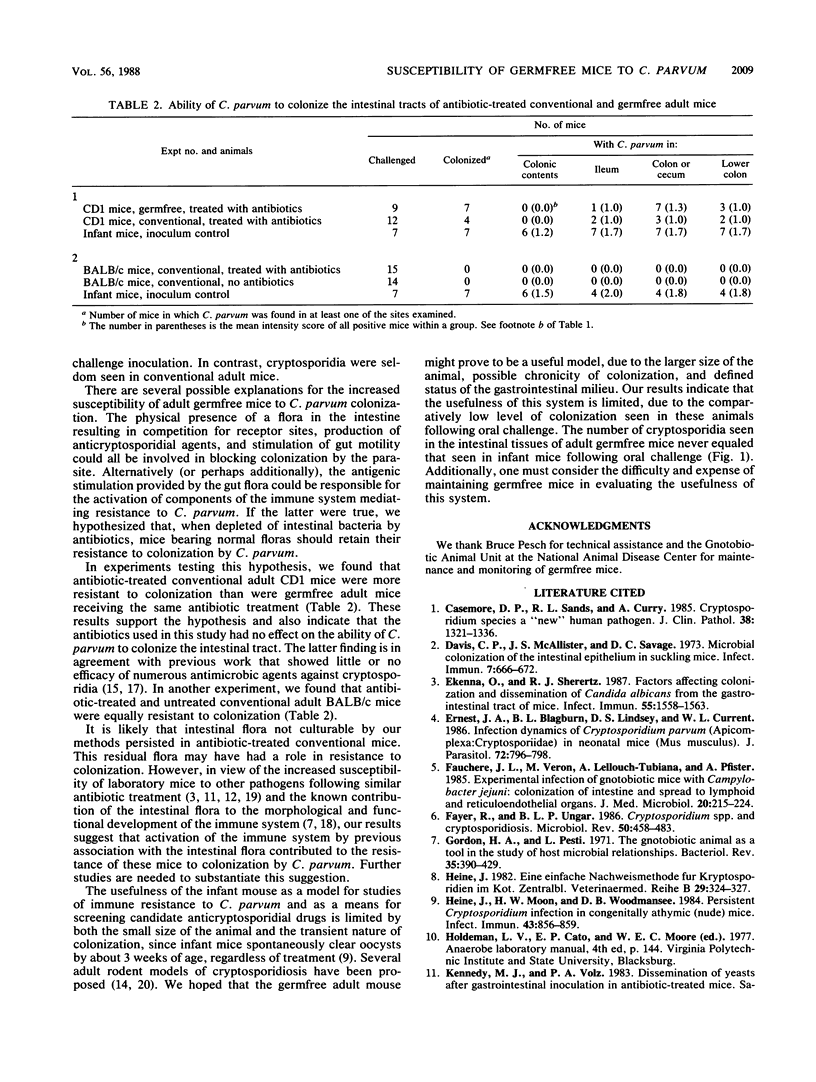
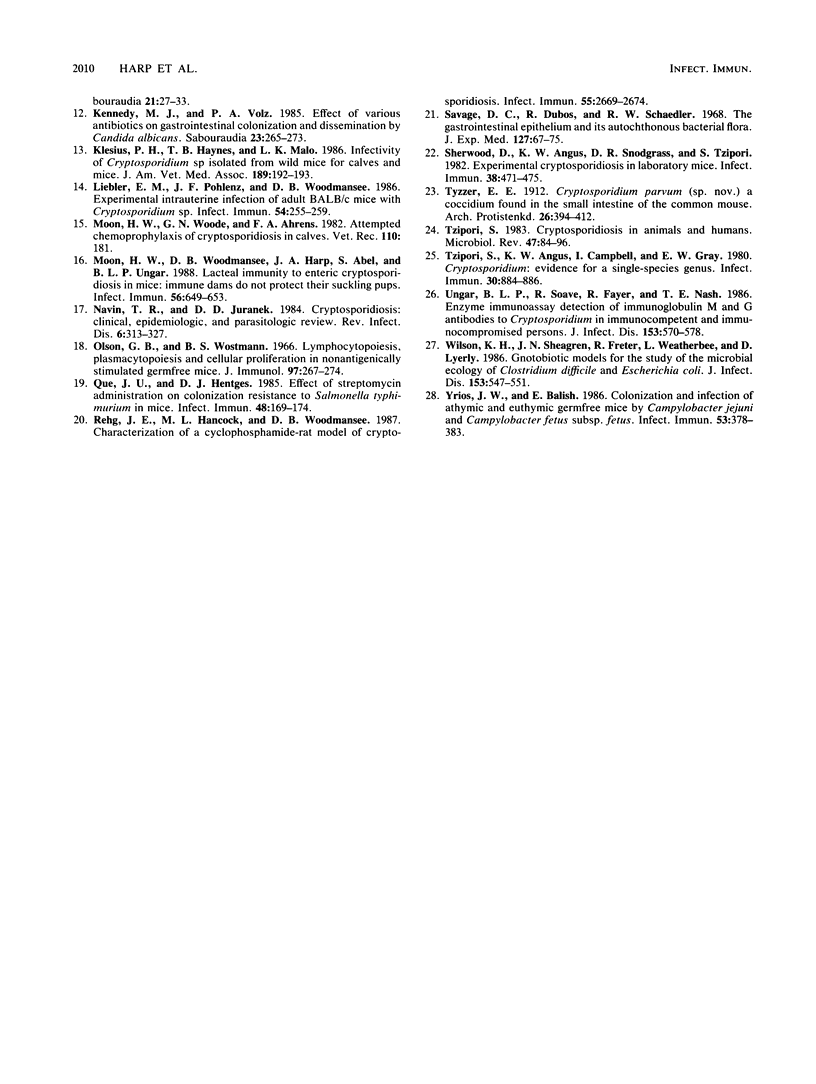
Images in this article
Selected References
These references are in PubMed. This may not be the complete list of references from this article.
- Casemore D. P., Sands R. L., Curry A. Cryptosporidium species a "new" human pathogen. J Clin Pathol. 1985 Dec;38(12):1321–1336. doi: 10.1136/jcp.38.12.1321. [DOI] [PMC free article] [PubMed] [Google Scholar]
- Davis C. P., McAllister J. S., Savage D. C. Microbial colonization of the intestinal epithelium in suckling mice. Infect Immun. 1973 Apr;7(4):666–672. doi: 10.1128/iai.7.4.666-672.1973. [DOI] [PMC free article] [PubMed] [Google Scholar]
- Ekenna O., Sherertz R. J. Factors affecting colonization and dissemination of Candida albicans from the gastrointestinal tract of mice. Infect Immun. 1987 Jul;55(7):1558–1563. doi: 10.1128/iai.55.7.1558-1563.1987. [DOI] [PMC free article] [PubMed] [Google Scholar]
- Ernest J. A., Blagburn B. L., Lindsay D. S., Current W. L. Infection dynamics of Cryptosporidium parvum (Apicomplexa: Cryptosporiidae) in neonatal mice (Mus musculus). J Parasitol. 1986 Oct;72(5):796–798. [PubMed] [Google Scholar]
- Fauchère J. L., Véron M., Lellouch-Tubiana A., Pfister A. Experimental infection of gnotobiotic mice with Campylobacter jejuni: colonisation of intestine and spread to lymphoid and reticulo-endothelial organs. J Med Microbiol. 1985 Oct;20(2):215–224. doi: 10.1099/00222615-20-2-215. [DOI] [PubMed] [Google Scholar]
- Fayer R., Ungar B. L. Cryptosporidium spp. and cryptosporidiosis. Microbiol Rev. 1986 Dec;50(4):458–483. doi: 10.1128/mr.50.4.458-483.1986. [DOI] [PMC free article] [PubMed] [Google Scholar]
- Gordon H. A., Pesti L. The gnotobiotic animal as a tool in the study of host microbial relationships. Bacteriol Rev. 1971 Dec;35(4):390–429. doi: 10.1128/br.35.4.390-429.1971. [DOI] [PMC free article] [PubMed] [Google Scholar]
- Heine J. Eine einfache Nachweismethode für Kryptosporidien im Kot. Zentralbl Veterinarmed B. 1982 May;29(4):324–327. [PubMed] [Google Scholar]
- Heine J., Moon H. W., Woodmansee D. B. Persistent Cryptosporidium infection in congenitally athymic (nude) mice. Infect Immun. 1984 Mar;43(3):856–859. doi: 10.1128/iai.43.3.856-859.1984. [DOI] [PMC free article] [PubMed] [Google Scholar]
- Kennedy M. J., Volz P. A. Effect of various antibiotics on gastrointestinal colonization and dissemination by Candida albicans. Sabouraudia. 1985 Aug;23(4):265–273. doi: 10.1080/00362178585380391. [DOI] [PubMed] [Google Scholar]
- Klesius P. H., Haynes T. B., Malo L. K. Infectivity of Cryptosporidium sp isolated from wild mice for calves and mice. J Am Vet Med Assoc. 1986 Jul 15;189(2):192–193. [PubMed] [Google Scholar]
- Liebler E. M., Pohlenz J. F., Woodmansee D. B. Experimental intrauterine infection of adult BALB/c mice with Cryptosporidium sp. Infect Immun. 1986 Oct;54(1):255–259. doi: 10.1128/iai.54.1.255-259.1986. [DOI] [PMC free article] [PubMed] [Google Scholar]
- Moon H. W., Woode G. N., Ahrens F. A. Attempted chemoprophylaxis of cryptosporidiosis in calves. Vet Rec. 1982 Feb 20;110(8):181–181. doi: 10.1136/vr.110.8.181-a. [DOI] [PubMed] [Google Scholar]
- Moon H. W., Woodmansee D. B., Harp J. A., Abel S., Ungar B. L. Lacteal immunity to enteric cryptosporidiosis in mice: immune dams do not protect their suckling pups. Infect Immun. 1988 Mar;56(3):649–653. doi: 10.1128/iai.56.3.649-653.1988. [DOI] [PMC free article] [PubMed] [Google Scholar]
- Navin T. R., Juranek D. D. Cryptosporidiosis: clinical, epidemiologic, and parasitologic review. Rev Infect Dis. 1984 May-Jun;6(3):313–327. doi: 10.1093/clinids/6.3.313. [DOI] [PubMed] [Google Scholar]
- Olson G. B., Wostmann B. S. Lymphocytopoiesis, plasmacytopoiesis and cellular proliferation in nonantigenically stimulated germfree mice. J Immunol. 1966 Aug;97(2):267–274. [PubMed] [Google Scholar]
- Que J. U., Hentges D. J. Effect of streptomycin administration on colonization resistance to Salmonella typhimurium in mice. Infect Immun. 1985 Apr;48(1):169–174. doi: 10.1128/iai.48.1.169-174.1985. [DOI] [PMC free article] [PubMed] [Google Scholar]
- Rehg J. E., Hancock M. L., Woodmansee D. B. Characterization of cyclophosphamide-rat model of cryptosporidiosis. Infect Immun. 1987 Nov;55(11):2669–2674. doi: 10.1128/iai.55.11.2669-2674.1987. [DOI] [PMC free article] [PubMed] [Google Scholar]
- Savage D. C., Dubos R., Schaedler R. W. The gastrointestinal epithelium and its autochthonous bacterial flora. J Exp Med. 1968 Jan 1;127(1):67–76. doi: 10.1084/jem.127.1.67. [DOI] [PMC free article] [PubMed] [Google Scholar]
- Sherwood D., Angus K. W., Snodgrass D. R., Tzipori S. Experimental cryptosporidiosis in laboratory mice. Infect Immun. 1982 Nov;38(2):471–475. doi: 10.1128/iai.38.2.471-475.1982. [DOI] [PMC free article] [PubMed] [Google Scholar]
- Tzipori S., Angus K. W., Campbell I., Gray E. W. Cryptosporidium: evidence for a single-species genus. Infect Immun. 1980 Dec;30(3):884–886. doi: 10.1128/iai.30.3.884-886.1980. [DOI] [PMC free article] [PubMed] [Google Scholar]
- Tzipori S. Cryptosporidiosis in animals and humans. Microbiol Rev. 1983 Mar;47(1):84–96. doi: 10.1128/mr.47.1.84-96.1983. [DOI] [PMC free article] [PubMed] [Google Scholar]
- Ungar B. L., Soave R., Fayer R., Nash T. E. Enzyme immunoassay detection of immunoglobulin M and G antibodies to Cryptosporidium in immunocompetent and immunocompromised persons. J Infect Dis. 1986 Mar;153(3):570–578. doi: 10.1093/infdis/153.3.570. [DOI] [PubMed] [Google Scholar]
- Wilson K. H., Sheagren J. N., Freter R., Weatherbee L., Lyerly D. Gnotobiotic models for study of the microbial ecology of Clostridium difficile and Escherichia coli. J Infect Dis. 1986 Mar;153(3):547–551. doi: 10.1093/infdis/153.3.547. [DOI] [PubMed] [Google Scholar]
- Yrios J. W., Balish E. Colonization and infection of athymic and euthymic germfree mice by Campylobacter jejuni and Campylobacter fetus subsp. fetus. Infect Immun. 1986 Aug;53(2):378–383. doi: 10.1128/iai.53.2.378-383.1986. [DOI] [PMC free article] [PubMed] [Google Scholar]



